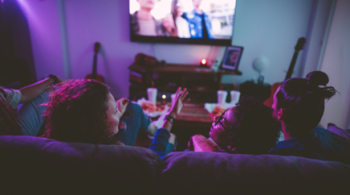The best TVs are getting sharper, clearer, and brighter every year, boasting innovations in panel technology, better picture processing, and more support for Ultra HD formats.
Put simply, the TV shows, movies, and boxsets you watch via Freeview Play have never looked better. However, there are some easy tweaks you can make at home to improve that picture quality even more.
It may seem like a no-brainer, but there’s more to getting the most out of your TV than simply taking it out of the box and hitting the ‘on’ button. Adjusting your TV picture mode can make a world of difference – and best of all, it’s one of the simplest things you can do to take your viewing experience to the next level.
What are TV picture modes?
Usually found in your TV’s settings menu, picture modes adjust lots of other settings in one go to change the overall look of the image you see onscreen. These settings usually include:
- Colour temperature - how warm or cool the image appears
- Backlight – this changes the brightness of the screen (note OLED TVs don’t feature a backlight, but often have their own equivalent setting)
- Motion interpolation – reduces the blurry effect of fast-moving images
- Gamma – similar to adjusting the brightness/contrast, this affects how dark the dark parts of the screen appear, and vice versa
- Edge enhancement – this exaggerates the edges of objects onscreen
Different TV manufacturers may have slightly different modes for their picture modes, but most will offer something like the below.
The best TV picture modes for every type of content
Standard/default
Take your new TV out of the box, and this is the mode you’ll probably find as soon as you switch it on.
Ideal for general TV watching like the news and daytime TV, it sets the contrast, brightness, and sharpness right down the middle and usually has a cooler temperature than other modes.
Perhaps not the most exciting, nor true-to-life picture mode, your TV’s standard/default is likely best suited to the widest range of lighting conditions thanks to its equally balanced settings. This makes it a good bet if you watch TV morning, noon, and night.
Movie/cinema
The clue is in the name: if you want the most accurate, true to the director’s vision picture for your films, your TV’s cinema or movie mode is your best choice.
Warmer than the TV’s default setting, this mode may appear reddish at first, but this is probably because you’re most used to your screen with a cooler colour temperature.
Overall, the look is very organic, with realistic shadows and detailed bright spots. Naturally, cinema/movie mode lends itself to big budget dramas, as well as films – though its dimmer appearance can make things difficult to make out in very light conditions, so it’s best to keep movie/cinema mode for evening viewing.
Vivid/Dynamic
In stark contrast to the natural look of cinema/movie mode, vivid/dynamic mode dials up the saturation for super bright colours that pop onscreen.
The downside to this mode is that it can make colours appear oversaturated, and its cooler colour temperature means it often looks slightly artificial. Try it out for yourself: you may find the increased brightness and contrast works well in brightly lit rooms, and the vivid colours can look good with animated content.
For most types of content, though, you’re better off using one of the other picture modes on offer.
Sports
Like vivid/dynamic mode, most TV sports modes increases the colour and contrast of the picture – useful if you’re watching a football match and need to be able to pick out the different players.
While motion interpolation can look artificially smooth, this is the mode where it works best; reducing the blur on fast-moving images is pretty useful if you’re watching something like tennis and want to keep your eye on the ball.
Game
Firing up your console? Your TV’s game mode is what you want to be using. This clever setting reduces input lag, so there’s no delay between you pressing a button on your controller and what you see onscreen.
Turning on game mode will usually affect the picture itself, too, making videogame graphics appear more vibrant, detailed, and colourful.
How else can I improve my TV’s picture?
Once you’ve picked a pre-set picture mode, there’s nothing stopping you from adjusting individual image settings to your liking – just head to your TV’s settings menu and tweak the brightness, contrast, colour temperature, and more to your heart’s content.
The only thing we’d recommend leaving alone, is the sharpness/edge enhancement. Turning this up can create a halo effect around objects onscreen, and rarely looks good.
Don’t forget to play around with your TV’s audio settings, too – tweaking the controls can make movies more immersive, dialogue easier to understand, and live sports feel like your sat in the stadium cheering on your favourite team.



